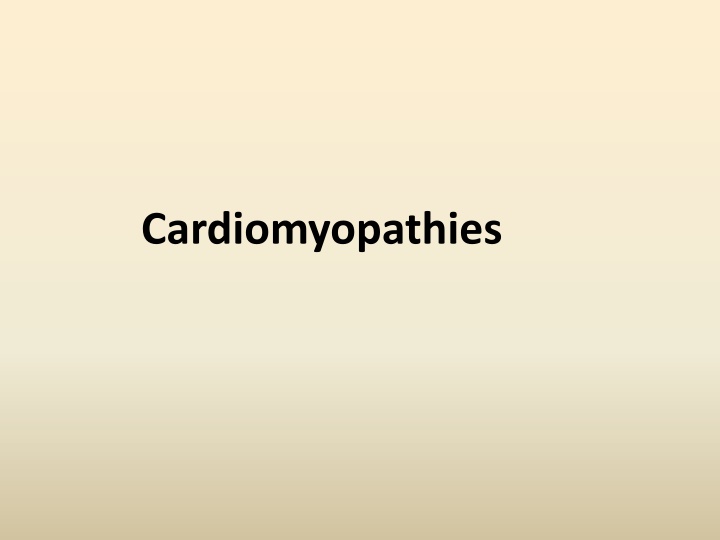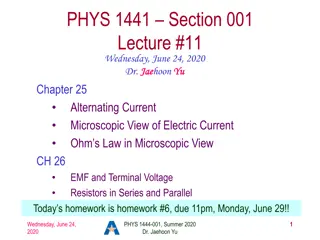
Cardiomyopathies and Their Types
Cardiomyopathies are diseases of the heart muscle associated with cardiac dysfunction. They are classified into different types such as Dilated Cardiomyopathy (DCM), Hypertrophic Cardiomyopathy (HCM), Restrictive Cardiomyopathy (RCM), and more. Dilated Cardiomyopathy, characterized by ventricular dilation and impaired contractile performance, can develop due to various factors such as myocarditis, toxins, infections, and genetic mutations. The pathobiology includes systolic dysfunction and insults to myocyte integrity, potentially leading to heart failure. Immune-mediated pathogenesis and genetic predisposition play crucial roles in the development of dilated cardiomyopathy.
Uploaded on | 1 Views
Download Presentation

Please find below an Image/Link to download the presentation.
The content on the website is provided AS IS for your information and personal use only. It may not be sold, licensed, or shared on other websites without obtaining consent from the author. If you encounter any issues during the download, it is possible that the publisher has removed the file from their server.
You are allowed to download the files provided on this website for personal or commercial use, subject to the condition that they are used lawfully. All files are the property of their respective owners.
The content on the website is provided AS IS for your information and personal use only. It may not be sold, licensed, or shared on other websites without obtaining consent from the author.
E N D
Presentation Transcript
Cardiomyopathy "heart muscle diseases of unknown cause" Diseases of the myocardium associated with cardiac dysfunction
Classification Dilated cardiomyopathy (DCM) Hypertrophic cardiomyopathy (HCM) Restrictive cardiomyopathy (RCM) Arrhythmogenic right ventricular cardiomyopathy/dysplasia (ARVC/D) Unclassified cardiomyopathies
Dilated Cardiomyopathy Dilated cardiomyopathy is characterized by ventricular dilation and impaired contractile performance, which may involve the left or both ventricles
May develop as a consequence of prior myocarditis or as a result of a recognized toxin, infection, predisposing cardiovascular disease (e.g., hypertension, ischemic or valvular heart disease When no cause or associated disease is identified, dilated cardiomyopathy has been termed idiopathic 50 to 60% of such patients have familial disease, and disease-causing mutations currently can be identified in 10 to 20% of such families.
Pathobiology Systolic dysfunction may result from a variety of causes Altered hemodynamic parameters of decreased stroke volume and increased chamber pressures trigger the recognized neurohumoral changes of heart failure
The insult to myocyte integrity may be relatively acute and may trigger programmed cell death (apoptosis); Insidious progression is the rule in inherited dilated cardiomyopathy and is also seen with viral persistence, anthracycline toxicity, and autoimmune dilated cardiomyopathy
A trigger with immune-mediated pathogenesis in genetically predisposed individuals Mutations in genes encoding important structural proteins in 20 to 30% of families with dilated cardiomyopathy Sarcomeric genes (10%) and lamin A/C (5%) One third of probands and family members develop low-titer, organ-specific autoantibodies to cardiac - myosin Viral persistence has also been implicated as an ongoing trigger of immune-mediated damage
Clinical Manifestations Gradual decrease in exercise capacity may be appreciated only in retrospect. The initial presentation is often with acute decompensation triggered by an unrelated problem, such as anemia, thyrotoxicosis, or infection
Symptoms relating to raised filling pressures: orthopnea, nocturnal cough, paroxysmal nocturnal dyspnea, peripheral edema Precede symptoms of low cardiac output: Fatigue, dyspnea on exertion
Diagnosis Signs or symptoms of heart failure accompanied by indices of advanced left ventricular impairment and dilation An early diagnosis of dilated cardiomyopathy requires consideration of the common recognized causes: systemic hypertension, valvular heart disease, associated systemic disorders, high-output states, and the muscular dystrophies
ECG The changes of early disease are not specific and may include: left axis deviation and T wave abnormalities. With progressive and advanced disease, conduction abnormalities develop: PR prolongation, QRS widening, and left bundle branch block
Echocardiogram As a baseline and for serial assessment to monitor disease progression and the effect of treatment
MRI Gadolinium-enhanced magnetic resonance imaging may be very helpful in differentiating segmental wall motion abnormalities in dilated cardiomyopathy from previous myocardial infarction
Biopsy Occasionally should be considered in patients with potential unexplained myocarditis.
Treatment Supportive therapy includes: Sodium and fluid restriction, Avoidance of alcohol and other toxins, Use of established heart failure medications
Alcoholic Cardiomyopathy Alcohol and its metabolite, acetaldehyde, are cardiotoxins acutely and chronically. Myocardial depression is initially reversible but, if sustained, can lead to irreversible vacuolization, mitochondrial abnormalities, and fibrosis The amount of alcohol necessary to produce symptomatic cardiomyopathy in susceptible individuals is not known Abstinence leads to improvement in at least 50% of patients with severe symptoms, some of whom normalize their left ventricular ejection fractions
Chemotherapy Doxorubicin (Adriamycin) cardiotoxicity causes characteristic histologic changes on endomyocardial biopsy, with overt heart failure in 5 to 10% of patients who receive doses greater than or equal to 450 mg/m2 of body surface area Cyclophosphamide and ifosfamide can cause acute severe heart failure and malignant ventricular arrhythmias 5-Fluorouracil can cause coronary artery spasm and depressed left ventricular contractility. Trastuzumab has been associated with an increased incidence of heart failure
Metabolic Causes Excess catecholamines, as in pheochromocytoma Cocaine increases synaptic concentrations of catecholamines by inhibiting reuptake at nerve terminals; the result may be an acute coronary syndrome or chronic cardiomyopathy.
Thiamine deficiency can cause beriberi heart disease, with vasodilation and high cardiac output followed by low output. Calcium deficiency resulting from hypoparathyroidism, gastrointestinal abnormalities, or chelation directly compromises myocardial contractility. Hypophosphatemia which may occur in alcoholism, during recovery from malnutrition, and in hyperalimentation, also reduces myocardial contractility. Patients with magnesium depletion owing to impaired absorption or increased renal excretion also may present with left ventricular dysfunction.
Skeletal Myopathies Duchenne's muscular dystrophy and Becker's X-linked skeletal muscle dystrophy typically include cardiac dysfunction Maternally transmitted mitochondrial myopathies such as Kearns-Sayre syndrome frequently cause cardiac myopathic changes
Peripartum Cardiomyopathy Peripartum cardiomyopathy appears in the last month of pregnancy or in the first 5 months after delivery in the absence of preexisting cardiac disease Lymphocytic myocarditis, found in 30 to 50% of biopsy specimens, suggests an immune component The prognosis is improvement to normal or near- normal ejection fraction during the next 6 months in more than 50% of patients.
Hypertrophic Cardiomyopathy Genetically determined myocardial disease Defined clinically by the presence of unexplained left ventricular hypertrophy Pathologically by the presence of myocyte disarray surrounding increased areas of loose connective tissue
Usually familial, with autosomal dominant inheritance. Abnormalities in sarcomeric contractile protein genes account for approximately 50 to 60% of cases
Gene MYH7 Protein -Myosin heavy chain Frequency 25 35% MYBPC3 Cardiac myosin binding protein C 20 30% TNNT2 Cardiac troponin T 3 5% TNNI3 Cardiac troponin I <5% TPM1 -Tropomyosin <5% MYL2 Regulatory myosin light chain <5% MYL3 Essential myosin light chain Rare ACTC -Cardiac actin Rare TTN Titin Rare TNNC1 Cardiac troponin C Rare MYH6 -Myosin heavy chain Single study CRP3 Muscle LIM protein Rare
Pathology Typically, heart weight is increased and the interventricular septum is hypertrophic, Any pattern of thickening may occur Histologically, the hallmark of hypertrophic cardiomyopathy is myocyte disarray. Results from the loss of the normal parallel arrangement of myocytes, with cells forming in whorls around foci of connective tissue
Left ventricular hypertrophy is usually associated with: hyperdynamic indices of systolic performance, impaired diastolic function, clinical features suggestive of ischemia
Clinical expression of left ventricular hypertrophy usually occurs during periods of rapid somatic growth, May be during the first year of life or childhood but more typically during adolescence and, occasionally, in the early 20s
Most patients are asymptomatic or have only mild or intermittent symptoms. Symptomatic progression is usually slow, age related, and associated with a gradual deterioration in left ventricular function over decades
Symptoms may develop at any age, even many years after the appearance of LVH Occasionally, sudden death may be the initial presentation
30% of adults develop exertional chest pain Atypical, prolonged, and noted at rest or nocturnally. Postprandial angina associated with mild exertion is typical. Mild to moderate dyspnea is common in adults 20% of patients experience syncope Palpitations are a frequent complaint Sustained palpitations are usually caused by supraventricular tachyarrhythmias
Diagnosis The initial diagnostic evaluation includes a family history focusing on premature cardiac disease or death
DIAGNOSTIC CRITERIA FOR HYPERTROPHIC CARDIOMYOPATHY Major Criteria ECHOCARDIOGRAPHY Left ventricular wall thickness 13 mm in the anterior septum or posterior wall or 15 mm in the posterior septum or free wall Severe SAM of the mitral valve (septal-leaflet contact) Minor Criteria Left ventricular wall thickness of 12 mm in the anterior septum or posterior wall or of 14 mm in the posterior septum or free wall Moderate SAM of the mitral valve (no mitral leaflet- septal contact) Redundant mitral valve leaflets ELECTROCARDIOGRAPHY Left ventricular hypertrophy with repolarization changes (Romhilt and Estes) Complete bundle branch block or (minor) interventricular conduction defects (in left ventricular leads) Minor repolarization changes in left ventricular leads Deep S wave in lead V2(>25 mm) T wave inversion in leads I and aVL ( 3 mm) (with QRS-T wave axis difference 30 degrees), V3 V6( 3 mm) or II and III and aVF ( 5 mm) Abnormal Q waves (>40 msec or >25% R wave) in at least two leads from II, III, aVF (in absence of left anterior hemiblock), and V1 V4; or I, aVL, V5 V6 Unexplained chest pain, dyspnea, or syncope
Differential Diagnosis Causes of left ventricular hypertrophy: -Long-standing systemic hypertension -Aortic stenosis -Highly trained athletes
Treatment In the absence of a specific underlying cause or aggravating factor, treatment is for the various stages of heart failure Supportive therapy includes sodium and fluid restriction, avoidance of alcohol and other toxins, and use of established heart failure medications
Restrictive Cardiomyopathy Characterized by impaired filling and reduced diastolic volume of the left and/or right ventricle despite normal or near-normal systolic function and wall thickness
Primary forms are uncommon, Secondary forms, the heart is affected as part of a multisystem disorder, Usually present at the advanced stage of an infiltrative disease (e.g., amyloidosis or sarcoidosis) or a systemic storage disease (e.g., hemochromatosis).
Restrictive cardiomyopathy may be familial Part of the genetic and phenotypic expression of hypertrophic cardiomyopathy caused by sarcomeric contractile protein gene abnormalities
Secondary forms: - amyloidosis, hemochromatosis, several of the glycogen storage diseases, and Fabry's disease Reported in association with skeletal myopathy and conduction system disease as part of the phenotypic spectrum caused by mutations in lamin A or C.
CAUSES OF RESTRICTIVE CARDIOMYOPATHIES INFILTRATIVE DISORDERS Amyloidosis Sarcoidosis STORAGE DISORDERS Hemochromatosis Fabry's disease Glycogen storage diseases FIBROTIC DISORDERS Radiation Scleroderma Drugs (e.g., doxorubicin, serotonin, ergotamine) METABOLIC DISORDERS Carnitine deficiency Defects in fatty acid metabolism ENDOMYOCARDIAL DISORDERS Endomyocardial fibrosis Hypereosinophilic syndrome (Lofler's endocarditis) MISCELLANEOUS CAUSES Carcinoid syndrome
Pathophysiology Increased stiffness of the endocardium or myocardium, induces ventricular pressures to rise disproportionately to small changes in volume until a maximum is reached.
In infiltrative diseases such as amyloidosis or sarcoidosis, the increased stiffness results from infiltrates within the interstitium between myocardial cells. In the storage disorders, the deposits are within the cells
Clinical Manifestations Presenting clinical features develop as a consequence of raised ventricular filling pressures Not distinguishable from those of heart failure resulting from systolic impairment Atrial dilation and atrial fibrillation are common
Diagnosis Based on the demonstration of the abnormal filling pattern by Doppler echocardiography Magnetic resonance imaging is useful to delineate the distribution of disease






















